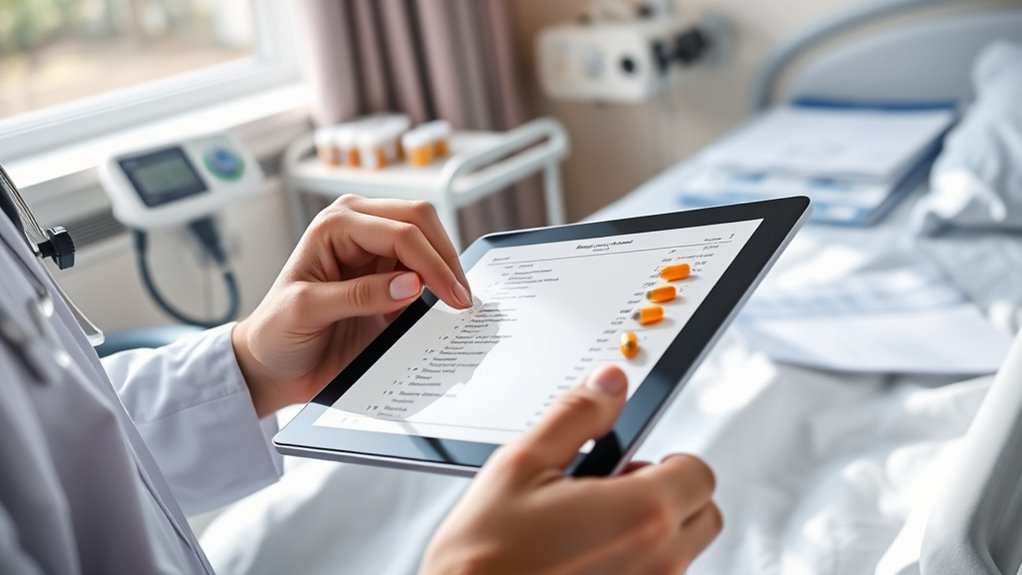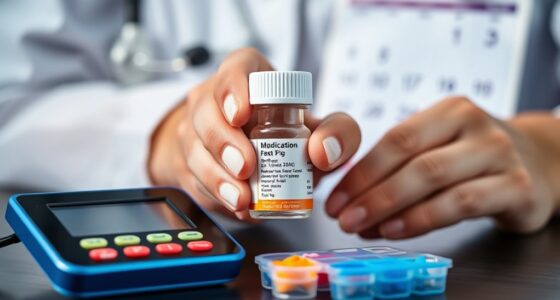After hospital discharge, medication reconciliation guarantees your medication list is accurate, safe, and up-to-date. It involves verifying your medicines, understanding their purposes, and communicating any changes with your healthcare team. Challenges like incomplete lists or poor communication can lead to errors or adverse events. Using tools like pill organizers or digital apps, plus involving caregivers, can make the process smoother. Keep going to discover more ways to improve medication safety after leaving the hospital.
Key Takeaways
- Ensuring accurate and updated medication lists post-discharge reduces errors and adverse events.
- Effective communication among healthcare providers and with patients is essential for successful reconciliation.
- Utilizing tools like medication charts, pill organizers, and digital apps enhances accuracy and adherence.
- Standardized processes and comprehensive documentation help prevent discrepancies during medication transfer.
- Continuous evaluation of reconciliation practices improves patient safety and reduces hospital readmissions.
Understanding the Importance of Post-Discharge Medication Reconciliation

After a hospital stay, ensuring your medication list is accurate and up-to-date becomes essential. Proper medication reconciliation helps you maintain medication adherence by clarifying which drugs you should continue, adjust, or stop. It also reduces the risk of dangerous drug interactions that could occur if medications are combined improperly. When your healthcare team reviews your medications, they can identify potential issues early, making sure your treatments are safe and effective. This process prevents errors, such as missed doses or duplicate therapies, that could compromise your recovery. Staying actively involved in medication reconciliation empowers you to understand your prescribed therapies and communicate any concerns. Additionally, involving patients in the process has been shown to improve medication adherence and overall health outcomes. Ultimately, verifying your medication list after discharge promotes better health outcomes and safer medication use.
Common Challenges Faced During Medication Reconciliation Processes

You’ll often encounter challenges like incomplete medication lists, which can lead to errors. Communication breakdowns among staff make it harder to guarantee everyone is on the same page. Additionally, patients may struggle to understand their medication changes, increasing the risk of non-adherence. Ensuring accurate medication information is maintained throughout the process is essential for patient safety.
Incomplete Medication Lists
Why do incomplete medication lists pose such a significant challenge during reconciliation? They increase the risk of medication discrepancies and prescribing errors, which can harm patient safety. When medication lists are incomplete, you might miss essential drugs or dosage details. This can lead to confusion and potential adverse events. To address this, focus on:
- Verifying all current medications with the patient and caregivers to fill gaps.
- Cross-checking hospital records and pharmacy data to ensure accuracy.
- Identifying and correcting discrepancies before discharge to prevent errors.
- Ensuring proper documentation supports medication safety and continuity of care.
Communication Breakdowns Among Staff
Communication breakdowns among staff can profoundly hinder the medication reconciliation process, leading to errors and delays. When team members don’t effectively communicate, interprofessional collaboration suffers, increasing the risk of missing or incorrect information. Poor documentation accuracy often results from unclear or incomplete messages, making it harder to verify medication lists and identify discrepancies. These gaps can cause crucial details to be overlooked, risking patient safety and treatment continuity. To prevent this, foster open, consistent communication channels and ensure that all team members understand their roles. Use standardized documentation practices and checklists to promote accuracy. Incorporating vetted medication safety products and tools can further enhance the process. By improving communication among staff, you help streamline medication reconciliation, reduce errors, and support safer, more reliable patient care after discharge.
Patient Understanding Challenges
Patients often face challenges in understanding their medication regimens during reconciliation, which can lead to errors and non-adherence. Low patient literacy makes it harder to grasp instructions, while medication myths can cause confusion or mistrust. To improve understanding, focus on these key issues:
- Misconceptions about medications: Patients may believe myths about side effects or interactions, affecting how they take their meds.
- Limited health literacy: Difficulty reading or comprehending medical instructions leads to mistakes.
- Communication barriers: Language differences or unclear explanations hinder proper understanding.
- Utilizing vetted educational resources can also help patients better understand their medication plans, reducing errors and promoting adherence.
Key Steps in Conducting Effective Medication Reconciliation

To conduct effective medication reconciliation, you need to follow a series of clear, organized steps that guarantee accuracy and safety. Start by collecting a complete and current medication list from the patient, including prescriptions, over-the-counter drugs, and supplements. Next, compare this list with the hospital records to identify discrepancies, such as omissions, duplications, or incorrect dosages. Verify each medication’s purpose and review potential drug interactions to enhance medication safety. Document any changes clearly and communicate them to the patient and relevant providers. Incorporate pharmacovigilance practices to monitor for adverse effects after discharge. This systematic approach ensures medications are accurately aligned with the patient’s current condition, reducing errors, supporting medication safety, and promoting positive health outcomes. Additionally, understanding the divorce process in various states can provide insight into legal procedures and requirements, which is crucial for those navigating family law.
Roles and Responsibilities of Healthcare Team Members

Effective medication reconciliation after hospital discharge depends on the coordinated efforts of various healthcare team members, each with specific roles and responsibilities. Your team must engage in interprofessional collaboration to guarantee medication safety protocols are followed.
- As a pharmacist, you verify medication lists, identify discrepancies, and communicate changes to the team.
- As a physician, you review and approve medication plans, ensuring they align with the patient’s clinical needs.
- As a nurse, you educate the patient about their medications and ensure understanding during discharge.
Clear communication and shared accountability are essential to prevent errors. By working together, your team enhances medication safety and ensures a smooth transition from hospital to home, reducing potential adverse events.
Engaging Patients and Caregivers in Medication Management

Effective medication management relies on clear communication strategies that guarantee you and your caregivers understand your treatment plan. Empowering caregivers to take an active role helps prevent errors and promotes safety. Using simplified medication tools can make managing complex regimens easier for everyone involved. Incorporating automation technologies can further streamline medication management processes and reduce the risk of errors.
Clear Communication Strategies
Clear communication is essential for engaging patients and caregivers in medication management after hospital discharge. To improve understanding and confirm medication adherence, focus on these strategies:
- Use simple language and verify understanding by asking patients to repeat instructions.
- Clearly explain the purpose of each medication and any potential side effects, emphasizing the importance of adherence.
- Coordinate closely with the pharmacy to ensure prescriptions are filled correctly and promptly, reducing errors and delays.
Empowering Caregiver Roles
Engaging caregivers actively in medication management can profoundly improve patient outcomes after hospital discharge. When you empower caregivers with proper medication safety knowledge, they become essential allies in ensuring medications are taken correctly. Caregiver education should focus on understanding medication schedules, potential side effects, and the importance of adherence. By involving caregivers early, you help prevent medication errors and reduce readmissions. Encourage open communication, so they feel confident in asking questions and reporting concerns. Providing clear instructions and resources enables caregivers to monitor for adverse reactions and confirm proper administration. Ultimately, your efforts in empowering caregivers create a safer medication environment, support patient recovery, and foster shared responsibility for health management beyond the hospital stay.
Simplified Medication Tools
Simplified medication tools play a crucial role in helping patients and caregivers manage medications safely and confidently. These tools make it easier to stay organized and avoid missed doses. One effective option is using pill organizers, which divide doses by day and time, reducing confusion. Medication charts are another helpful resource, providing a clear overview of prescribed medicines, dosages, and schedule. To maximize their benefits, consider these steps:
- Use pill organizers daily to keep track of multiple medications.
- Maintain updated medication charts to review and verify prescriptions.
- Share these tools with your healthcare team to ensure consistency and safety.
- Incorporate medication adherence strategies to improve consistent use of prescribed treatments.
Tools and Technologies to Support Reconciliation Efforts

To effectively support medication reconciliation efforts after hospital discharge, healthcare providers rely on a variety of tools and technologies designed to streamline the process and reduce errors. Medication apps enable real-time access to patient medication lists, facilitate updates, and improve communication among care teams. Digital checklists help guarantee no step is missed during reconciliation, promoting accuracy and consistency. These tools improve efficiency and patient safety by minimizing manual entry errors and providing clear, organized information. Additionally, ensuring color accuracy in digital displays can enhance the clarity and reliability of medication information presented to providers.
Strategies for Overcoming Barriers to Accurate Medication Lists

Achieving accurate medication lists after hospital discharge often faces obstacles such as incomplete documentation, communication gaps, and patient misunderstanding. To improve medication safety, you can adopt specific strategies.
- Implement clear policies that standardize medication reconciliation processes, ensuring consistency and accountability across care teams.
- Use multidisciplinary communication channels, like electronic health records and direct provider-patient conversations, to bridge gaps.
- Educate patients about their medications, clarifying instructions to prevent misunderstandings.
Measuring Success and Improving Reconciliation Practices

Measuring success in medication reconciliation begins with establishing clear, specific metrics that reflect both process and outcome improvements. You should track medication adherence rates, noting how well patients follow their prescribed regimens. Additionally, evaluate patient education effectiveness by assessing understanding of medication changes. To guide improvements, consider this table:
| Metric | Goal |
|---|---|
| Medication adherence | Increase by 15% |
| Patient education sessions | Conduct for 90% of discharged patients |
| Reconciliation accuracy | Reduce errors by 20% |
| Readmission rates | Decrease within 30 days |
| Patient satisfaction | Improve scores related to medication understanding |
Regularly reviewing these metrics helps you identify gaps and refine your practices, ensuring safer, more effective medication reconciliation. Incorporating preppy dog names as part of patient engagement strategies can also enhance patient rapport and adherence.
Frequently Asked Questions
How Often Should Medication Reconciliation Be Performed After Discharge?
You should perform medication reconciliation as soon as possible after discharge, ideally within 24 hours. Then, it’s important to review medication timing and verify the patient understands their regimen through patient education. Follow-up should occur within 7 days to catch any issues or discrepancies. Regular ongoing reviews help prevent errors, improve adherence, and ensure the patient’s safety, making timely reconciliation vital during the shift from hospital to home.
What Are Common Signs of Medication Discrepancies in Patients?
They say “trust, but verify,” and it’s true for medication safety too. You might notice signs like unexplained side effects, missed doses, or worsening symptoms, which could signal medication discrepancies. Recognizing these signs helps prevent medication errors and enhances patient safety. Stay vigilant for changes in behavior, adverse reactions, or inconsistent medication use, and always communicate with healthcare providers to guarantee accurate, safe medication management after discharge.
How Can Technology Improve Accuracy in Medication Lists?
You can improve accuracy in medication lists by leveraging technology like electronic records and patient portals. Electronic records automatically update and sync medication data, reducing errors. Patient portals empower you to review and confirm your medication lists directly, ensuring all information is current and accurate. By using these tools, you minimize discrepancies, promote safety, and make medication management more efficient, giving you greater confidence in your prescribed treatments.
What Training Is Necessary for Healthcare Providers?
You need to receive training that emphasizes pharmacy collaboration and patient education. This guarantees you understand how to accurately update medication lists, verify prescriptions, and communicate effectively with patients about their medications. Training should also cover the importance of clear documentation and teamwork, so you can prevent errors and enhance patient safety. By mastering these skills, you help ensure seamless medication management and improved health outcomes.
How Do Cultural Factors Influence Medication Adherence?
Imagine you’re steering a river with different currents. Cultural beliefs and language barriers act as hidden currents, guiding your medication adherence. If you understand your patient’s cultural beliefs, you can adjust your approach, making it easier for them to follow their regimen. Overcoming language barriers guarantees clarity, so they don’t drift off course. Recognizing these influences helps you build trust and support their journey to better health.
Conclusion
By prioritizing thorough medication reconciliation after hospital discharge, you can prevent harmful errors and improve patient outcomes. Think about the theory that accurate medication lists save lives—it’s true. When you stay vigilant and involve patients actively, you’re not just following procedures; you’re truly making a difference. Embrace the tools and strategies available, because every correct medication record is a step toward safer, better care. Your efforts truly matter.









